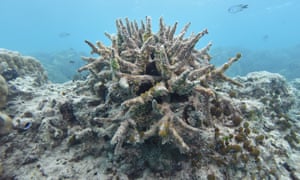http://e-info.org.tw/node/117440
生態系崩壞前兆 大堡礁部分地區魚群完全消失!
文字大小
389 3 Share1

本報2016年8月2日綜合外電報導,姜唯編譯;蔡麗伶審校
澳洲大堡礁今年上半年發生大規模珊瑚白化,這個月則有專家觀察到魚群開始消失。據了解,魚群消失是生態系統全面崩壞的指標之一。
澳洲昆士蘭大學學者、公民科學計畫「珊瑚礁監測」首席調查員馬歇爾(Justin Marshall)上月底指出,大堡礁部分地區生態系統崩壞,魚群數量驟減,僅存的珊瑚入冬後也持續白化。

大堡礁今年4、5月發生大規模珊瑚白化事件。圖片來源:The Ocean Agency。(CC BY-NC)
「依我觀察,整體而言魚群剩不到白化前的50%,部分物種甚至完全看不到了。」馬歇爾說。這個月他花了一週時間在蜥蜴島進行珊瑚礁調查。
馬歇爾說,許多枝狀珊瑚附近常見的魚類完全消失,包括黑白斑雀鯛,而原本該區到處都有的青魔魚這次只見到一群。
馬歇爾指出,魚群消失是生態系統全面崩壞的指標之一。存活珊瑚不夠,魚類沒有棲身之所和食物,便會死亡或移居他處。少了部分魚類,由於整個生態系統被破壞,珊瑚更難復原。
此外,儘管南半球冬天帶來冷水,大堡礁珊瑚仍持續白化。
馬歇爾也觀察到部分珊瑚復原,部分海葵白化但是沒有死亡。整體而言,據馬歇爾估計,蜥蜴島超過90%的枝狀珊瑚以及許多活了上千年的巨型微孔珊瑚已死亡。
海水溫度過高且持續過久,珊瑚、海葵和巨蛤等生物會開始白化。當這些生物受到壓力,便釋出供應牠們養分的彩色共生藻類,變成白色。除非水溫快速恢復正常,否則這些生物便會死亡。在這次全球性珊瑚白化潮中,蜥蜴島受創尤其嚴重,大堡礁近1/4的珊瑚死亡。但是大堡礁北部,蜥蜴島和托雷斯海峽之間,大部分珊瑚都死亡了。
據了解,氣候變遷是造成今年珊瑚大規模白化的主因,使海水溫度逼近珊瑚所能忍受的上限,而強大的聖嬰現象則是最後一根稻草。
Sections of Great Barrier Reef suffering from 'complete ecosystem collapse'
Coral Watch investigator reports ‘shocking’ lack of fish and says the surviving corals are continuing to bleach, even during winter
“Complete ecosystem collapse” is being seen on parts of the Great Barrier Reef, as fish numbers tumble and surviving corals continue to bleach into winter, according to a scientist returning from one of the worst-hit areas.
“The lack of fish was the most shocking thing,” said Justin Marshall, of the University of Queensland and the chief investigator of citizen science program Coral Watch. “In broad terms, I was seeing a lot less than 50% of what was there [before the bleaching]. Some species I wasn’t seeing at all.”
Marshall spent a week this month conducting surveys on the reefs around Lizard Island.
Marshall said many of the fish species that were commonly seen around branching coral had completely disappeared from the area, including the black-and-white striped humbug damselfish. He said in his time there he saw only one school of green chromis, which were previously seen all over the area.
Marshall said the lack of fish was an indication that there was “complete ecosystem collapse”. Without enough surviving corals, the fish didn’t have the shelter and food sources they needed and had died or moved elsewhere.
Without many of those fish, Marshall said the coral would face a harder time recovering, since the entire ecosystem had been degraded.
He said he was also surprised to see that some of the surviving corals continued to bleach, despite the southern hemisphere winter bringing cooler waters to the Great Barrier Reef.
“There are still corals bleaching,” Marshall said. “Especially noticeable on Lizard Island were the soft corals. Some of them have remained bleached. And some of the hard corals are still white.”
He said many of them were probably not bleaching for the first time now but rather have remained bleached since it began. “They’re just holding on by the fingernails,” he said.
Marshall said he also saw some corals that had recovered, as well as some anemones that had bleached but not died.
But, overall, Marshall estimate that more than 90% of the branching corals had died around Lizard Island. He said many of the huge porites corals, which could be a thousand years old, had died.
Coral and other organisms like anemones and giant clams bleach when water temperatures are too high for too long. When they become stressed, they expel their colourful symbiotic algae that provide them with energy, becoming pale or white. Unless the water temperatures quickly return to normal, many of those organisms die.
Lizard Island was particularly badly hit by the global bleaching event that hit every major reef region in the world and killed almost a quarter of the coral on the Great Barrier Reef. But, in the northern section of the Great Barrier Reef, between Lizard Island and the Torres Strait, a majority of the coral is thought to have died.
The mass bleaching this year was driven by climate change, which raised water temperatures close to the maximum threshold coral could stand, and a strong El Niño that bumped the temperatures above that threshold.



沒有留言:
張貼留言